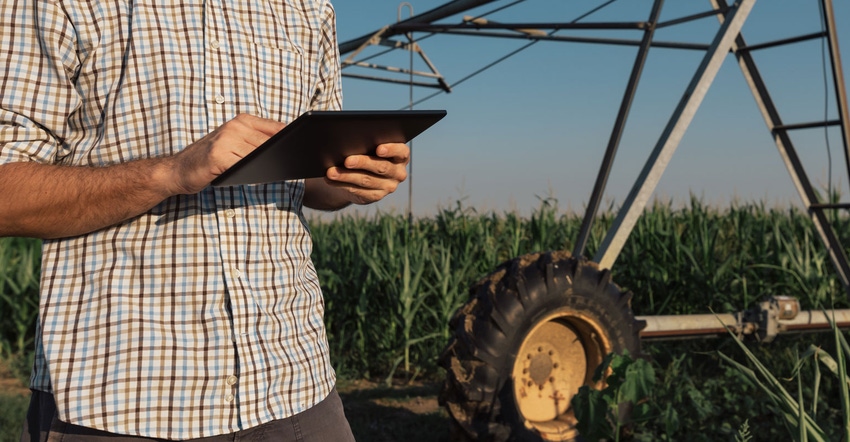
There are many things to growing a good corn crop. Ben Riensche, owner and manager of Blue Diamond Farming Co. in Iowa, can think of at least 99 things he has to think about every year before he takes his planter into the field. And we haven’t even gotten to Mother Nature yet.
So, if technology can take some of the variabilities out of making some of those decisions, he’s all for it. But at what price?
This is the debate behind outcome-based pricing, which Bayer and its subsidiary, The Climate Corp., have been testing this year on farms in the Corn Belt.
The idea behind outcome-based pricing, at least according to Bayer, is sharing the risk and reward of corn hybrid and input recommendations with farmers. And it’s all based on the company’s technology and data.
It works like this: A farmer is given a yield guarantee based on a corn hybrid, treatments and other things they have to do in the field. If Bayer’s yield guarantee comes through, or it’s exceeded, the farmer and the company split the upside 50-50. If it falls below expectations, the farmer pays less in inputs.
At a Farm Foundation Forum in Washington, D.C., Chad Bilby, North America commercial innovation experimentation lead with Bayer Crop Science, said farmers want tailored solutions so they can get the most out of every acre, including good fertility and seed treatments.
They are also looking for financial security and want more choices, he said.
According to an October article in The Missouri Ruralist, farmers must have Climate FieldView in order to participate in the program. They must also have historical data on how hybrids are managed in those fields.
Seed Advisor was the company’s first foray into predicting seed performance in fields. With advances in digital technologies, Bilby said there are more opportunities than ever to match seed and products to fields, thus creating a new business model based on the value of the company’s products.
“Really, everything hinges on the farmer value they can see," Bilby said. “We see this as another choice farmers can have.”
Many questions
Bilby said the pilot program will continue in 2020 on select farms in the Corn Belt.
Rienshe is a big user of Climate FieldView and even commented that he was on the Climate FieldView app just before the Farm Foundation Forum to keep an eye on things back home.
From his standpoint, he sees outcome-based pricing as paying for a bundle of services in exchange for a sliding price: If he gets a lower yield, he pays less; if he gets a better yield, he pays more.
But he also has lots of questions. How will the effects of weather play into the program? This year was a stark reminder of that with record rainfall and cold preventing many acres from being planted. About 11% of Rienshe’s corn crop is still in the field, he said.
Seed is not the only thing he looks at when making decisions for an upcoming growing season. He focuses on picking the right seed for the average weather because at the end of the day, Mother Nature affects everything.
While crop care products are a big decision, too, many substitutes are available from other companies that can do just as good a job on his farm, he said.
And when it comes to technology, it still has a long way to go. Case in point: On a farm that he manages with his aunt the yield monitor, equipped with Climate FieldView, came back with a 185-bushel yield. At the elevator, the yield was 224 bushels, even though he just calibrated the combine a day or two before harvest.
“It’s going to have to get a lot more reliable. I don't want to be accused of lying about my yields," he said.
Still, he sees a fit for outcome-based pricing with beginning or thinly capitalized farmers who need to minimize risk, or for use in areas with more marginal soils and greater production variability.
“If you get in the margins of the Corn Belt, it might be a good fit for them, too,” he said.
Another management tool
Joe Young, president and chief operating officer of Growers Edge Financial, said he sees outcome-based pricing as a new way to get the newest technologies on farms faster.
He said it’s another tool for farmers to better manage cash flow. He noted that net farm income has been on the decline the past several years and that farm bankruptcies — up 30% since 2014 — will likely continue increasing.
“At Growers Edge, we’re trying to make sure to improve farm profitability. We’re trying to take risk out of the equation,” he said.
The market is flooded with farm technologies, from better seeds to advances in precision ag. Young said it’s difficult for farmers to make sense of it all, especially when the banker is telling them to cut costs and tighten their belts. He said farmers need to focus on getting the most return on their investment no matter what technology they want to use.
“Outcome-based pricing is not for everyone,” he said. “Some people will find a benefit, some will not.”
Using data
Of course, none of this is possible without farmer cooperation, and in the case of outcomes-based pricing that means sharing data.
The Climate Corp.’s policy is that farmers own the data, and Bilby reiterated that policy once again during the forum. But understanding a farm and variabilities within fields is crucial to making a system like this work, he said, and it’s only possible if farmers are willing to share that data.
During Bayer’s Future of Farming Dialogue in Monheim, Germany, this past summer, Sam Eathington, chief science officer with The Climate Corp., said the company had to adjust its data use policy with farmers in the program.
“But of course, outcome-based pricing requires us to use the data for pricing. We have to use the data. We are going to use this data to figure out a price on your farm,” he said, adding that farmers in the program were receptive to the change.
Young said it’s crucial for companies to be “exceptionally transparent” about their data use and communicate up-front with farmers.
About the Author(s)
You May Also Like






